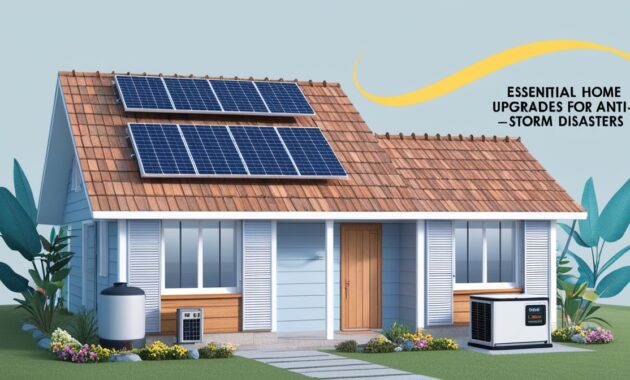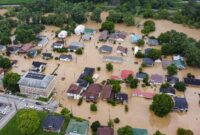When storms and floods strike, your home’s resilience depends heavily on the upgrades and preventive measures you’ve invested in.
Beyond regular maintenance, there are critical home improvements that can safeguard property, minimize financial loss, and ensure the safety of everyone living there.
Below is a complete guide to essential home upgrades designed to protect against storms and floods:

1. Reinforced Roofing Systems
A strong roof is your first line of defense during heavy storms.
- Impact-Resistant Shingles: Choose shingles rated for high winds and impact resistance.
- Hurricane Straps: Metal ties that secure the roof to the house structure, preventing uplift.
- Roof Inspection: Regularly inspect for loose shingles or tiles that could become projectiles.
2. Storm-Resistant Windows and Doors
Windows and doors are common failure points in extreme weather.
- Impact-Resistant Glass: Windows made with laminated glass resist shattering.
- Storm Shutters: Install roll-down or accordion shutters for quick deployment.
- Reinforced Garage Doors: Upgrade to wind-rated doors with heavy-duty bracing.
3. Flood-Resistant Foundations
Floodwaters can weaken foundations quickly.
- Seal Cracks and Openings: Use waterproof sealant on foundation walls.
- Install a Sump Pump: Essential for homes in flood-prone areas to remove accumulating water.
- Flood Vents: These allow water to flow through crawlspaces, reducing structural damage from hydrostatic pressure.
4. Elevated Electrical Systems
Flooding and electricity do not mix safely.
- Raise Electrical Outlets: Install outlets, switches, and circuit breakers above the expected flood level.
- Backup Generators: Keep power running to essential systems like sump pumps and refrigerators.
- Waterproof Electrical Boxes: Use sealed boxes and conduit in lower levels or basements.
5. Proper Drainage Systems
Good drainage reduces both flood and erosion risks.
- Gutter Maintenance: Keep gutters clear to ensure water flows away from the house.
- French Drains: These systems redirect surface water away from your foundation.
- Grading the Landscape: Ensure the soil slopes away from the home’s base.
6. Waterproofing Basements and Crawlspaces
Basements are particularly vulnerable to water infiltration.
- Interior Sealants: Apply water-resistant coatings on basement walls and floors.
- Exterior Waterproofing Membranes: Protect against water seeping through from the outside.
- Drainage Tile Systems: Installed around the perimeter of the basement to direct water away.
7. Wind-Resistant Exterior Walls
For homes in hurricane-prone areas, the walls need reinforcement.
- Concrete Block Construction: Stronger than wood framing for high-wind events.
- Reinforced Sheathing: Plywood or OSB panels securely fastened with wind-rated fasteners.
- Storm Bracing Systems: Additional framing support for critical load-bearing walls.
8. Smart Home Monitoring Systems
Technology can help you monitor your home’s condition during storms.
- Flood Sensors: Alert you to water presence in key areas.
- Wind and Weather Sensors: Provide real-time data on storm conditions.
- Remote-Controlled Shutters: Deploy storm protection even when you’re not home.
9. Backup Water and Emergency Supplies
In case of prolonged storm events:
- Water Storage Tanks: Ensure access to clean water if public supplies are interrupted.
- Emergency Kits: Stock flashlights, batteries, first-aid supplies, and non-perishable food.
- Fire Extinguishers and Safety Equipment: Storm damage can increase fire risks.
10. Landscaping for Storm and Flood Defense
Your yard can either help or hurt your flood resilience.
- Native Plants: Deep-rooted plants help absorb water.
- Retaining Walls: Prevent soil erosion and redirect runoff.
- Rain Gardens: Designed to collect and filter stormwater naturally.
Final Thoughts
Storms and floods are inevitable in many regions, but with these essential home upgrades, you can significantly reduce potential damage and improve your family’s safety. While some measures involve professional installation, others are simple DIY steps that homeowners can undertake gradually.
For best results, combine several of these upgrades to create a comprehensive defense system. Prioritize based on your local climate risks—whether that’s hurricanes, flash floods, or winter storms—and always consult local building codes and professionals where required.
Here are key things to avoid when building a storm- and flood-protected building:
Single-Layer Wall Construction:
Thin, unreinforced walls provide little protection. Multi-layer systems with waterproof membranes are safer.
Low-Elevation Sites:
Avoid building in floodplains, near rivers, or in areas prone to storm surges.
Weak Foundation Systems:
Avoid shallow or poorly anchored foundations. Skipping elevation or piling systems in flood-prone zones is a major risk.
Lightweight or Flimsy Materials:
Materials like untreated wood, plastic panels, or low-grade metal sheets can fail during high winds or heavy rain.
Flat Roof Designs Without Proper Drainage:
Flat roofs without reinforced structures and adequate drainage can collapse or collect water, leading to leaks and damage.
Basements in Flood-Prone Areas:
Avoid basements in high-risk flood zones, as they are difficult to waterproof against rising groundwater.
Poor-Quality Windows and Doors:
Standard glass and non-reinforced doors may shatter or blow in during storms. Impact-rated products are preferable.
Ignoring Building Codes and Standards:
Skipping local storm- or flood-resistance codes can leave your building vulnerable and non-compliant.
Inadequate Drainage Planning:
Avoid neglecting systems like sump pumps, French drains, and sloped landscaping to direct water away from the building.
Heavy Exterior Fixtures:
Avoid installing heavy signs, awnings, or decorative items that can become dangerous projectiles in high winds.






